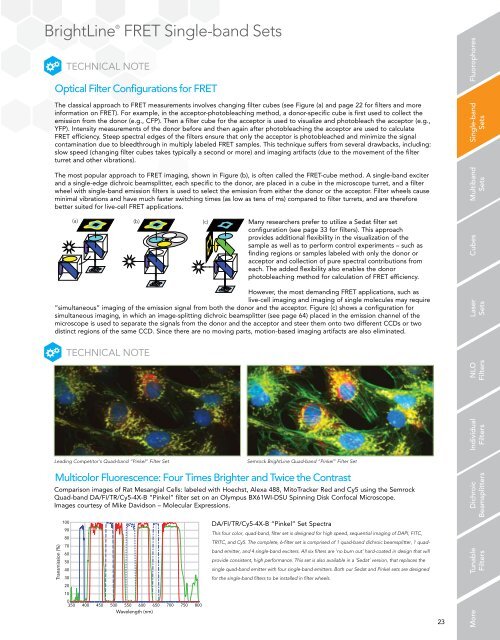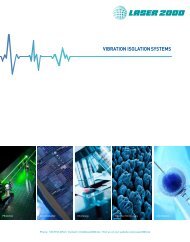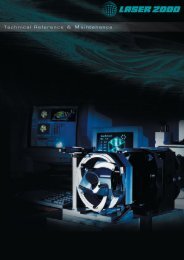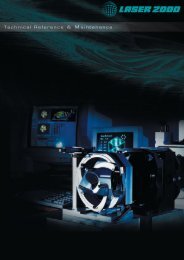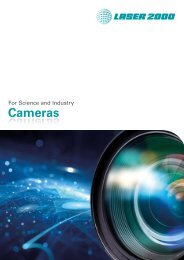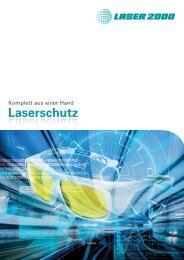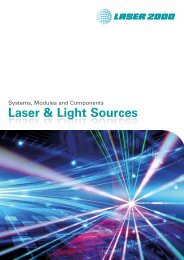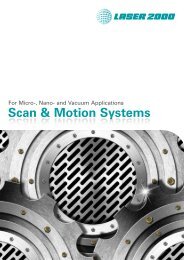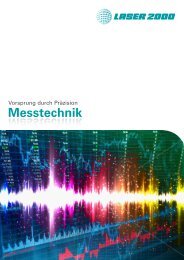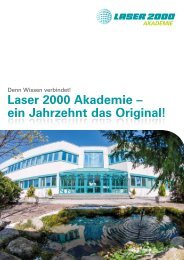Semrock Master Catalog 2018
Semrock Master Catalog 2018
Semrock Master Catalog 2018
You also want an ePaper? Increase the reach of your titles
YUMPU automatically turns print PDFs into web optimized ePapers that Google loves.
BrightLine ® FRET Single-band Sets<br />
TECHNICAL NOTE<br />
Optical Filter Configurations for FRET<br />
The classical approach to FRET measurements involves changing filter cubes (see Figure (a) and page 22 for filters and more<br />
information on FRET). For example, in the acceptor-photobleaching method, a donor-specific cube is first used to collect the<br />
emission from the donor (e.g., CFP). Then a filter cube for the acceptor is used to visualize and photobleach the acceptor (e.g.,<br />
YFP). Intensity measurements of the donor before and then again after photobleaching the acceptor are used to calculate<br />
FRET efficiency. Steep spectral edges of the filters ensure that only the acceptor is photobleached and minimize the signal<br />
contamination due to bleedthrough in multiply labeled FRET samples. This technique suffers from several drawbacks, including:<br />
slow speed (changing filter cubes takes typically a second or more) and imaging artifacts (due to the movement of the filter<br />
turret and other vibrations).<br />
The most popular approach to FRET imaging, shown in Figure (b), is often called the FRET-cube method. A single-band exciter<br />
and a single-edge dichroic beamsplitter, each specific to the donor, are placed in a cube in the microscope turret, and a filter<br />
wheel with single-band emission filters is used to select the emission from either the donor or the acceptor. Filter wheels cause<br />
minimal vibrations and have much faster switching times (as low as tens of ms) compared to filter turrets, and are therefore<br />
better suited for live-cell FRET applications.<br />
Fluorophores<br />
Single-band<br />
Sets<br />
Multiband<br />
Sets<br />
(a) (b) (c)<br />
Many researchers prefer to utilize a Sedat filter set<br />
configuration (see page 33 for filters). This approach<br />
provides additional flexibility in the visualization of the<br />
sample as well as to perform control experiments – such as<br />
finding regions or samples labeled with only the donor or<br />
acceptor and collection of pure spectral contributions from<br />
each. The added flexibility also enables the donor<br />
photobleaching method for calculation of FRET efficiency.<br />
Cubes<br />
However, the most demanding FRET applications, such as<br />
live-cell imaging and imaging of single molecules may require<br />
“simultaneous” imaging of the emission signal from both the donor and the acceptor. Figure (c) shows a configuration for<br />
simultaneous imaging, in which an image-splitting dichroic beamsplitter (see page 64) placed in the emission channel of the<br />
microscope is used to separate the signals from the donor and the acceptor and steer them onto two different CCDs or two<br />
distinct regions of the same CCD. Since there are no moving parts, motion-based imaging artifacts are also eliminated.<br />
Laser<br />
Sets<br />
TECHNICAL NOTE<br />
Individual<br />
Filters<br />
NLO<br />
Filters<br />
Leading Competitor’s Quad-band “Pinkel” Filter Set<br />
<strong>Semrock</strong> BrightLine Quad-band “Pinkel” Filter Set<br />
Multicolor Fluorescence: Four Times Brighter and Twice the Contrast<br />
Comparison images of Rat Mesangial Cells: labeled with Hoechst, Alexa 488, MitoTracker Red and Cy5 using the <strong>Semrock</strong><br />
Quad-band DA/FI/TR/Cy5-4X-B “Pinkel” filter set on an Olympus BX61WI-DSU Spinning Disk Confocal Microscope.<br />
Images courtesy of Mike Davidson – Molecular Expressions.<br />
DA/FI/TR/Cy5-4X-A<br />
Dichroic<br />
Beamsplitters<br />
Transmission (%)<br />
DA/FI/TR/Cy5-4X-B “Pinkel” Set Spectra<br />
This four color, quad-band, filter set is designed for high speed, sequential imaging of DAPI, FITC,<br />
TRITC, and Cy5. The complete, 6-filter set is comprised of 1 quad-band dichroic beamsplitter, 1 quadband<br />
emitter, and 4 single-band exciters. All six filters are ‘no burn out’ hard-coated in design that will<br />
provide consistent, high performance. This set is also available in a ‘Sedat’ version, that replaces the<br />
single quad-band emitter with four single-band emitters. Both our Sedat and Pinkel sets are designed<br />
for the single-band filters to be installed in filter wheels.<br />
Tunable<br />
Filters<br />
100<br />
90<br />
80<br />
70<br />
60<br />
50<br />
40<br />
30<br />
20<br />
10<br />
0<br />
350 400 450 500 550 600 650 700 750<br />
Wavelength (nm)<br />
800<br />
23<br />
More


